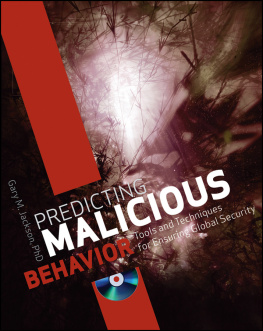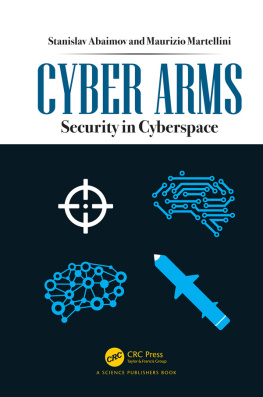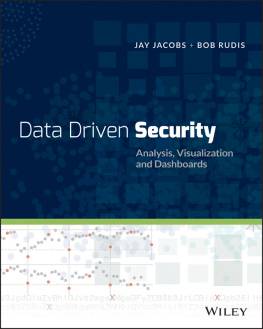Part I
Understanding the Dark Side: Malicious Intent
In This Part
Chapter 1: Analyzing the Malicious Individual
Chapter 2: Analyzing the Malicious Group
Chapter 3: Analyzing Country-Level Threats
Chapter 4: Threats and Security Nightmares: Our Current Reactive State of Security
Chapter 5: Current Network Security
Chapter 6: Future Threats to Our National Security
Chapter 1
Analyzing the Malicious Individual
We are all as unique as our fingerprints. No two of us are alike. Even identical twins exhibit different behavior under different circumstances. We are born with a genetic design that dictates our eye and hair color, height, weight, temperament, musical ability, and an immense number of other attributes. However, through life's experiences we are molded by a combination of biology and environment to be who we are and to behave the way we do.
We all respond continuously to events and situations in our environment that precede our behavior. We continually respond to any environmental context in which we find ourselves. As stated in the Introduction, a behavioral perspective considers these preceding events and situations to be antecedents. When we do exhibit behavior in the presence of precursor events, our behavior has consequences. Antecedents prompt behavior to occur, and consequences maintain it, increase it, or decrease it in the future, based on the desirability of the consequences. I refer to the antecedent-behavior-consequence sequence as ABC simply to use a less wordy term. In this chapter, you will learn to use ABC principles to help analyze malicious behavior. In later chapters you will learn how to use the concepts along with new methods to accurately anticipate malicious behavior.
Analyzing the Unique Individual
The method of behavior analysis presented in this book may be used to analyze and anticipate the behavior of an individual or group. When you compare the two, perhaps surprisingly, the individual often exhibits more behavioral variety than a group. Members of a group typically share common beliefs or are united for a common cause. The commonality among the members means that the group may act as a single entity, at least in some ways. They may respond to similar antecedent conditions with similar behaviors and are reinforced by similar consequences of their actions. Street gang members may dress alike, use the same slang, target the same individuals for harm, and remain in the gang because of bonded similarities. Although there are individual differences even within the members of a group, the commonalities simplify group analysis.
To ensure adequate analysis of the individual, the following are two of the most important principles to follow:
- First, we need to ensure that we have adequate and multiple observations of behavior under various conditions.
- Second, observations must include adequate descriptions so that we can identify the who, what, when, where, and how of past behaviors.
In the absence of observation we can use subject matter expert (SME) descriptions, but it is essential that the SMEs are knowledgeable.
Definition
A subject matter expert is someone who maintains knowledge and details of a specific topic at a level that is more extensive than that of others. For example, a cardiologist attains and maintains knowledge of the functioning of the heart that is much deeper than that possessed by other individuals.
We want to identify the antecedents, behavior, and consequences of past behavior (see Chapter 7 for details). Therefore, we seek to identify what environmental conditions serve as antecedents that precede the behavior of interest, as well as what follows the behaviorthe consequences. Multiple examples of all three componentsantecedents, behavior, and consequences, in that orderallow us to predict the person's future behavior when similar antecedents and the promise of similar consequences are present.
As a simple example to demonstrate the concepts, if we observe pedestrians crossing a busy intersection, we know that the crosswalk light will flash that it is okay to cross. The antecedents in this case are the flashing crosswalk light, followed immediately by the behavior of interestpedestrians crossing the intersection. The consequence is that pedestrians cross successfully without injury and with minimal risk. If the crossing light is not on and cross traffic is occurring, we can predict that pedestrians will not try to cross the intersection. Not crossing when the flashing crosswalk sign is not on with oncoming traffic again ensures safety at the intersection as a consequence. Therefore, we can predict with a high probability of success that when there is oncoming traffic, pedestrians will cross when the flashing crosswalk signal is on and will not cross when the signal is off. The antecedent controls the behavior.
However, with continued observation we are likely to determine that if the crosswalk light is not on and there is no oncoming traffic, pedestrians will likely cross quickly. This is a more complex and more accurate analysis. The behavior of crossing the intersection can be predicted accurately under two antecedent conditions: (1) the flashing crosswalk signal is on and traffic is stopped, and (2) the crosswalk signal is flashing or not flashing, but there is no oncoming traffic. Therefore, the two methods of crossing are likely to occur in the future because both lead to successful consequencesa safe crossing of the intersection.
Malicious behavior is very similar to this oversimplified example. Such behavior does not just happen. It occurs in response to environmental antecedents and is reinforced by the consequences of the behavior. For example, the presence of an abortion clinic and the comings and goings of the staff serve as antecedents (A) to an abortion clinic bomber. Committing a bombing is the behavior (B) that we are interested in predicting. The consequences (C) of the bombing, such as disruption of abortions stemming from physical damage, injury, or even death of the workers, reinforces the act of bombing. This ABC sequence forms the basis of behavioral modeling that has been shown to be predictive. The ability to predict future behavior is not based on a specific type of statistical method or detailed study of the behavior of interest. Prediction of behavior is based on the underlying antecedents and consequences associated with past behavior.
Note
The ability to predict future behavior is not based on a specific type of statistical method or calculation. Accurate anticipation of behavior is based on the underlying model and the components of behavior used to develop the predictive model.
Interestingly, the ability to predict behavior does not rely on the individual to be rational or sane. In many of our past clinical cases, we used applied behavior analysis to help treat psychotic episodes, hallucinations, delusional talk, and other forms of abnormal behavior. Even in cases where a person is considered mentally ill or deficient, his or her behavior may still be predicted accurately if ABC behavior principles are applied diligently. In short, everyone responds to the environment from their own perspective, regardless of whether the antecedent conditions are present, or valid, from their perspective. Whether the target of the analysis is a world leader, a terrorist, or the criminally insane, the ABC components help us analyze and predict their behavior.







